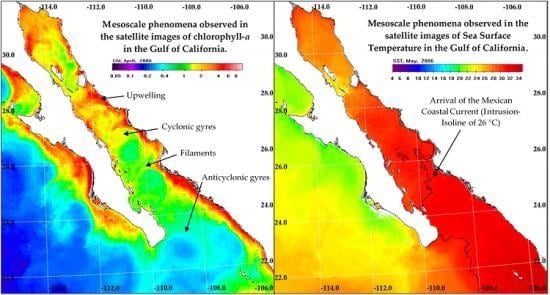Environmental Variability and Oceanographic Dynamics of the Central and Southern Coastal Zone of Sonora in the Gulf of California
Abstract
:1. Introduction
2. Materials and Methods
2.1. Study Area
2.2. Environmental Characterization and Oceanographic Dynamics
2.3. Statistical Analyses
3. Results
3.1. Analyses of Cumulative Annual and Monthly Frequency of Mesoscale Phenomena Observed in the Central and Southern Coastal Region of Sonora in the Gulf of California from 2002–2015
3.2. Analyses of Mesoscale Phenomena Observed Monthly by Images of Chlorophyll a
3.3. Monthly and Annual Analyses of Chlorophyll a, Sea Surface Temperature and Climate Indexes of the El Niño Southern Oscillation and Pacific Decadal Oscillation from 2002–2015
4. Discussion
5. Conclusions
Acknowledgments
Author Contributions
Conflicts of Interest
References
- Salazar-Sparks, J. Chile y la Comunidad del Pacífico; Editorial Universitaria: Santiago, Chile, 1999; 253p, ISBN 956111528X, 9789561115286. [Google Scholar]
- Zamudio, L.; Hogan, P.; Metzger, E.J. Summer generation of the Southern Gulf of California eddy train. J. Geophys. Res. 2008, 113. [Google Scholar] [CrossRef]
- Lluch-Cota, S.E. Gulf of California. In Marine Ecosystems of the North Pacific; PICES Special Publication: Sidney, BC, Canada, 2004; Volume 1, pp. 1–7, 1280. [Google Scholar]
- Lavin, M.F.; Beier, E.; Badan, A. Estructura hidrográfica y circulación del Golfo de California: Escalas estacional e interanual. In Contribuciones a la Oceanografía Física en México: Monografía; Lavín, F., Ed.; Unión Geofísica Mexicana: Ensenada, Baja California, México, 1997; pp. 141–171. [Google Scholar]
- Álvarez-Molina, L.L.; Álvarez-Borrego, S.; Lara-Lara, J.R.; Marinone, S. Annual and semiannual variations of phytoplankton biomass and production in the central Gulf of California estimated from satellite data. Cienc. Mar. 2013, 39, 217–230. [Google Scholar] [CrossRef]
- Stammer, D.; Wunsch, C. Temporal changes in eddy energy of the oceans. Deep Sea Res. 1999, 46, 77–108. [Google Scholar] [CrossRef]
- Lluch-Cota, S.E.; Aragon-Noriega, E.A.; Arreguin-Sánchez, F.; Aurioles-Gamboa, D.; Bautista Romero, J.; Brusca, R.C.; Cervantes-Duarte, R.; Cortéz-Altamirano, R.; Del-Monte-Luna, P.; Esquivel-Herrera, A.; et al. The Gulf of California: Review of ecosystem status and sustainability challenges. Prog. Oceanogr. 2007, 73, 1–26. [Google Scholar] [CrossRef]
- Maluf, L.Y. The Physical Oceanography. In Island Biogeography in the Sea of Cortez; Case, T.J., Cody, M.L., Eds.; University of California Press: Berkeley, CA, USA, 1983; pp. 26–45. [Google Scholar]
- Lluch-Cota, S.E. Coastal upwelling in the eastern Gulf of California. Oceanol. Acta 2000, 23, 731–740. [Google Scholar] [CrossRef]
- Ripa, P. Seasonal circulation in the Gulf of California. Ann. Geophys. 1990, 8, 559–564. [Google Scholar]
- Soto-Mardones, L.; Marinone, S.G.; Parés-Sierra, A. Variabilidad espaciotemporal de la temperatura superficial del mar en el Golfo de California. Cienc. Mar. 1999, 25, 1–30. [Google Scholar] [CrossRef]
- Marinone, S.G. A three-dimensional model of the mean and seasonal circulation of the Gulf of California. J. Geophys. Res. 2003, 108, 21–27. [Google Scholar] [CrossRef]
- Herrera-Cervantes, H.; Lluch-Cota, D.B.; Gutiérrez-de-Velasco, G.; Lluch-Cota, S.E. The ENSO signature in sea-surface temperature in the Gulf of California. J. Mar. Res. 2007, 65, 589–605. [Google Scholar] [CrossRef]
- Lavin, M.F.; Castro, R.; Beier, E.; Cabrera, C.; Godinez, V.M.; Amador-Buenrostro, A. Surface circulation in the Gulf of California in summer from surface drifters and satellite images (2004–2006). J. Geophys. Res. Oceans 2014, 119, 4278–4290. [Google Scholar] [CrossRef]
- Badan-Dangon, A. Coastal circulation from the Galapagos to the Gulf of California. In The Sea, Pan Regional; Robinson, A.R., Brink, K.H., Eds.; John Wiley and Sons: Hoboken, NJ, USA, 1998; Volume 11, pp. 315–343. [Google Scholar]
- Navarro-Olache, L.F.; Lavín, M.F.; Álvarez-Sánchez, L.G.; Zirino, A. Internal structure of SST features in the central Gulf of California. Deep Sea Res. II 2004, 51, 673–687. [Google Scholar] [CrossRef]
- Espinosa-Carreón, L.; Valdez-Holguín, E. Variabilidad interanual de la clorofila en Golfo de California. Ecol. Appl. 2007, 6, 83–92. [Google Scholar] [CrossRef]
- Hoffman, E.E.; Powell, T.M. Environmental variability effects on marine fisheries: Four case histories. Ecol. Appl. 1998, 8, 523–532. [Google Scholar]
- López-Martínez, J.; Rodríguez-Romero, J.; Hernández-Saavedra, N.Y.; Herrera-Valdivia, E. Population parameters of the Pacific flagfin mojarra Eucinostomus currani (Perciformes: Gerreidae) captured by the shrimp trawling fishery in the Gulf of California. Rev. Biol. Trop. 2011, 59, 887–897. [Google Scholar] [CrossRef] [PubMed]
- Rodríguez-Romero, J.; Barjau, E.; Galván, F.; Gutiérrez, F.; López, J. Estructura espacial y temporal de la comunidad de especies de peces arrecifales de la Isla San José, Golfo de California, México. Rev. Biol. Trop. 2012, 60, 2. [Google Scholar]
- Contreras-Catala, F.; Sánchez-Velasco, L.; Lavín, M.F.; Godínez, V.M. Three-dimensional distribution of larval fish assemblages in an anticyclonic eddy in a semi-enclosed sea (Gulf of California). J. Plankton Res. 2012, 34, 548–562. [Google Scholar] [CrossRef]
- García-Reyes, M.; Largier, J.L.; Sydeman, W.J. Synoptic-scale upwelling indices and predictions of phyto-and zooplankton populations. Prog. Oceanogr. 2014, 120, 177–188. [Google Scholar] [CrossRef]
- Lluch-Cota, S.E.; Morales Zárate, M.V.; Lluch Cota, D.B. Variabilidad del Clima y Pesquerías del Noroeste de México. En: Variabilidad Ambiental y Pesquerías de México; López-Martínez, J., Ed.; Comisión Nacional de Acuacultura y Pesca: Mazatlán, Sinaloa, México, 2008; p. 216. [Google Scholar]
- Sánchez-Velasco, L.; Lavín, M.F.; Jiménez-Rosenberg, S.P.A.; Godínez, V.M.; Santamaría del Angel, E.; Hernández-Becerril, D.U. Three-dimensional distribution of fish larvae in a cyclonic eddy in the Gulf of California during the summer. Deep Sea Res. I Oceanogr. Res. Pap. 2013, 75, 39–51. [Google Scholar] [CrossRef]
- Sánchez-Velasco, L.; Lavín, M.F.; Jiménez-Rosenberg, S.P.A.; Godínez, V.M. Preferred larval fish habitat in a frontal zone of the northern Gulf of California during the early cyclonic phase of the seasonal circulation (June 2008). J. Mar. Syst. 2014, 129, 368–380. [Google Scholar] [CrossRef]
- Coria-Monter, E.; Monreal-Gómez, M.A.; Salas de León, D.A.; Aldeco-Ramírez, J.; Merino-Ibarra, M. Differential distribution of diatoms and dinoflagellates in a cyclonic eddy confined in the Bay of La Paz, Gulf of California. J. Geophys. Res. 2014, 6258–6268. [Google Scholar] [CrossRef]
- Schwing, F.B.; Murphree, T.; Green, P.M. The Northern Oscillation Index (NOI): A New Climate Index for the Northeast Pacific. Prog. Oceanogr. 2002, 53, 115–139. [Google Scholar] [CrossRef]
- Parrish, R.H.; Schwing, F.B.; Mendelssohn, R. Mid-Latitude Wind Stress: The Energy Source for Climate Shifts in the North Pacific Ocean. Fish. Oceanogr. 2000, 9, 224–238. [Google Scholar] [CrossRef]
- Wooster, W.S.; Hollowed, A.B. Decadal-Scale Variations in the Eastern Subarctic Pacific, Winter Ocean Conditions. Can. Spes. Publ. Fish. Aquat. Sci. 1995, 121, 81–85. [Google Scholar]
- Bograd, S.J.; Chereskin, T.K.; Roemmich, D. Transport of Mass, Heat, Salt, and Nutrients in the Southern California Current System: Annual Cycle and Interannual Variability. J. Geophys. Res. 2001, 106, 9255–9275. [Google Scholar] [CrossRef]
- Bernal, P.A.; Chelton, D.B. Variabilidad biológica de baja frecuencia y gran escala en la Corriente de California, 1949–1978 (Low Frequency and Large-Scale Biological Variability in the California Current, 1949–1978). In Reports of the Expert Consultation to Examine Changes in Abundance and Species Composition of Neritic Fish Resources, Proceedings of the A Preparatory Meeting for the FAO World Conference on Fisheries Management and Development, San José, Costa Rica, 18–29 April 1983; FAO Fisheries Report; Csirke, J., Sharp, G.D., Eds.; The Food and Agriculture Organization of the United Nations (FAO): Rome, Italy, 1984; Volume 1, p. 102. [Google Scholar]
- Schwing, F.B.; Murphree, T.; deWitt, L.; Green, P.M. The Evolution of Oceanic and Atmospheric Anomalies in the Northeast Pacific during the El Nino and La Nina Events of 1995–2001. Progr. Oceanogr. 2002, 54, 459–491. [Google Scholar] [CrossRef]
- Deser, C.; Alexander, M.A.; Timlin, M.S. Evidence for a Wind-Driven Intensification of the Kuroshio Current Extension from the 1970s to the 1980s. J. Clim. 1999, 12, 1697–1706. [Google Scholar] [CrossRef]
- Barlow, M.; Nigam, S.; Berbery, E.H. ENSO, Pacific Decadal Variability, and US Summertime Precipitation, Drought, and Stream Flow. J. Clim. 2001, 14, 2105–2128. [Google Scholar] [CrossRef]
- Chiew, F.H.; McMahon, T.A. Global ENSO-Streamflow Teleconnection, Streamflow Forecasting and Interannual Variability. Hydrol. Sci. J. 2002, 47, 505–522. [Google Scholar] [CrossRef]
- Trenberth, K.E. The Definition of El Niño. Bull. Am. Meteorol. Soc. 1997, 78, 2771–2777. [Google Scholar] [CrossRef]
- Mantua, N.J.; Hare, S.R.; Zhang, Y.; Wallace, J.M.; Francis, R.C. A Pacific Interdecadal Climate Oscillation with Impacts on Salmon Production. Bull. Am. Meteorol. Soc. 1997, 78, 1069–1079. [Google Scholar] [CrossRef]
- Mantua, N.J.; Hare, S.R. The Pacific Decadal Oscillation. J. Oceanogr. 2002, 58, 35–44. [Google Scholar] [CrossRef]
- Mantua, N.J. The Pacific Decadal Oscillation and Climate Forecasting for North America; Joint Institute for the Study of the Atmosphere and Oceans, University of Washington: Seattle, WA, USA, 1999. [Google Scholar]
- Piechota, T.C.; Garbrecht, J.D.; Schneider, J.M. Climate Variability and Climate Change. In Climate Variations, Climate Change, and Water Resources Engineering; Garbrecht, J.D., Piechota, T.C., Eds.; ASCE: Reston, VA, USA, 2006; pp. 1–18. [Google Scholar]
- Makarov, V.G.; Jiménez-Illescas, A.R. Barotropic Background Currents in the Gulf of California. Cienc. Mar. 2003, 29, 141–153. [Google Scholar] [CrossRef]
- Lavín, M.F.; Palacios-Hernández, E.; Cabrera, C. Sea Surface Temperature Anomalies in the Gulf of California. Geofís. Int. 2003, 42, 363–375. [Google Scholar]
- Latif, M.; Barnett, T.P. Interactions of the Tropical Oceans. J. Clim. 1995, 8, 952–964. [Google Scholar] [CrossRef]
- Zhang, Y.; Wallace, J.M.; Battisti, D.S. ENSO-Like Interdecadal Variability: 1900–93. J. Clim. 1997, 10, 1004–1020. [Google Scholar] [CrossRef]
- Hare, S.; Mantua, N. Empirical Evidence for North Pacific Regime Shifts in 1977 and 1989. Progr. Oceanogr. 2000, 47, 103–145. [Google Scholar] [CrossRef]
- Martinez, E.; Antoine, D.; D’Ortenzio, F.; Gentili, B. Climate-Driven Basin-Scale Decadal Oscillations of Oceanic Phytoplankton. Science 2009, 326, 1253–1256. [Google Scholar] [CrossRef] [PubMed]
- Di Lorenzo, E.; Schneider, N.; Cobb, K.M.; Chhak, K.; Franks, P.J.S.; Miller, A.J.; McWilliams, J.C.; Bograd, S.J.; Arango, H.; Curchister, E.; et al. North Pacific Gyre Oscillation Links Ocean Climate and Ecosystem Change. Geophys. Res. Lett. 2008, 35, L08607. [Google Scholar] [CrossRef]
- Lluch-Cota, S.E.; Parés-Sierra, A.; Magaña-Rueda, V.O.; Arreguín Sánchez, F.; Bazzino, G.; Herrera-Cervantes, H.; Lluch Belda, D. Changing climate in the Gulf of California. Prog. Oceanogr. 2010, 87, 114–126. [Google Scholar] [CrossRef]
- Walther, G.-R.; Post, E.; Convey, P.; Menzel, A.; Parmesan, C.; Beebee, T.J.; Fromentin, J.M.; Hoegh-Guldberg, O.; Bairlein, F. Ecological responses to recent climate change. Nature 2002, 416, 389–395. [Google Scholar] [CrossRef] [PubMed]
- Helmuth, B.; Harley, C.D.G.; Halpin, P.M.; O’Donnell, M.; Hofmann, G.E.; Blanchette, C.A. Climate change and latitudinal patterns of intertidal thermal stress. Science 2002, 298, 1015–1017. [Google Scholar] [CrossRef] [PubMed]
- Lluch-Cota, S.E.; Tripp-Valdez, M.; Lluch-Cota, D.B.; Lluch-Belda, D.; Verbesselt, J.; Herrera-Cervantes, H.; Bautista-Romero, J.J. Recent trends in sea surface temperature off Mexico. Atmosfera 2013, 26, 537–546. [Google Scholar] [CrossRef]
- Edwards, M.; Richardson, A.J. Impact of climate change on marine pelagic phenology and trophic mismatch. Nature 2004, 430, 881–884. [Google Scholar] [CrossRef] [PubMed]
- Páez-Osuna, F.; Sánchez-Cabeza, J.A.; Ruiz-Fernández, A.C.; Alonso-Rodríguez, A.C.R.; Cardoso-Mohedano, J.G.; Flores-Verdugo, F.J.; Carballo, J.L.; Cisneros-Mata, M.A.; Piñón-Gimate, A.; Álvarez-Borrego, S. Environmental status of the Gulf of California: A review of responses to climate change and climate variability. Earth Sci. Rev. 2016, 162, 253–268. [Google Scholar] [CrossRef]
- Kahru, M.; Marinone, S.G.; Lluch-Cota, S.E.; Parés-Sierra, A.; Mitchell, G. Ocean color variability in the Gulf of California: Scales from the El Niño-La Niña cycle to tides. Deep Sea Res. II 2004, 51, 139–146. [Google Scholar] [CrossRef]
- Lavín, M.F.; Beier, E.; Gómez-Valdés, J.; Godínez, V.M.; García, J. On the summer poleward coastal current off SW México. Geophys. Res. Lett. 2006, 33. [Google Scholar] [CrossRef]
- Pegau, W.S.; Boss, E.; Martínez, A. Ocean color observations of eddies during the summer in the Gulf of California. Geophys. Res. Lett. 2002, 29, 6-1–6-3. [Google Scholar] [CrossRef]
- Kahru, M.; Kudela, R.M.; Manzano-Sarabia, M.; Mitchell, B.G. Trends in the surface chlorophyll of the California Current: Merging data from multiple ocean color satellites. Deep Sea Res. 2012, 77–80, 89–98. [Google Scholar] [CrossRef]
- Kahru, M. Windows Image Manager, WIM Software (Ver. 9.06) and User’s Manual. 2016, p. 125. Available online: http://www.wimsoft.com/ (accessed on 28 June 2017).
- Climate Prediction Center Internet Team NOAA/National Weather Service. National Centers for Environmental, Prediction, Climate, Prediction, Center. Available online: http://www.esrl.noaa.gov/psd/data/climateindices/list/ (accessed on 28 June 2017).
- López, J.M. Variabilidad Anual e Interanual de la Clorofila-(SeaWiFS) y el Viento Superficial (QuikSCAT) en el Alto Golfo de California: Su Circulación y Asociación. Master’s Thesis, Universidad Autónoma de Baja California, Ensenada, Mexico, 2005; p. 71. [Google Scholar]
- García-Morales, R.; Shirasago-German, B.; Felix-Uraga, R.; Perez-Lezama, E.L. Conceptual Model of Pacific Sardine Distribution in the California Current. Curr. Dev. Oceanogr. 2012, 5, 27–47. [Google Scholar]
- Lavín, M.F.; Marinone, S.G. An overview of the physical oceanography of the Gulf of California. In Nonlinear Processes in Geophysical Fluid Dynamics; Velasco Fuentes, O.U., Sheinbaum, J., Ochoa, J., Eds.; Kluwer Academic Publishers: Dordrecht, The Netherlands, 2003; pp. 173–204. [Google Scholar]
- Godínez-Sandoval, V.M. Dinámica y Termodinámica en la Entrada Exterior al Golfo De California. Ph.D. Thesis, Facultad de Ciencias Marinas, UABC, México, 2011; p. 139. [Google Scholar]
- Morel, A.; Berthon, J.F. Surface pigments, algal biomass profiles, and potential production of the euphotic layer: Relationships reinvestigated in view of remote-sensing applications. Limnol. Oceanogr. 1989, 34, 1545–1562. [Google Scholar] [CrossRef]
- Santamaría del Ángel, E.; Álvarez-Borrego, S.; Muller-Karger, F. Gulf of California biogeographic regions based on coastal zone color scanner imagery. J. Geophys. Res. 1994, 99, 7411–7421. [Google Scholar] [CrossRef]
- McGillicuddy, D.J., Jr.; Robinson, A.R.; Siegel, D.A.; Jannasch, H.W.; Johnsonk, R.; Dickey, T.D.; McNeil, J.; Michaels, A.F.; Knapk, A.H. Influence of mesoscale eddies on new production in the Sargasso Sea. Nature 1998, 394, 263–265. [Google Scholar] [CrossRef]
- Duxbury, A.C.; Duxbury, A.B.; Sverdrup, K.A. An Introduction to the World’s Oceans, 6th ed.; McGraw-Hill: New York, NY, USA, 2000; 528p. [Google Scholar]
- Morrow, R.; Fang, F.; Fieux, M.; Molcard, R. Anatomy of three warm-core Leeuwin current eddies. Deep Sea Res. II 2003, 50, 2229–2243. [Google Scholar] [CrossRef]
- Van Aken, H.M.; Van Veldhoven, A.K.; Veth, C.; De Ruijter, W.P.M.; Van Leeuwen, P.J.; Drijfhout, S.S.; Whittle, C.P.; Rouault, M. Observations of a young Agulhas ring, Astrid, during MARE in March 2000. Deep Sea Res. II 2003, 50, 167–195. [Google Scholar] [CrossRef]
- McGillicuddy, D.J., Jr.; Anderson, L.A.; Bates, N.R.; Bibby, T.; Buesseler, K.O.; Carlson, C.A.; Davis, C.S.; Ewart, C.; Falkowski, P.G.; Goldtwaith, S.A.; et al. Eddy/wind interactions stimulate extraordinary mid-ocean plankton blooms. Science 2007, 316, 1021–1026. [Google Scholar] [CrossRef] [PubMed]
- Robinson, C.J.; Gómez-Gutiérrez, J.; de León, D.A.S. Jumbo squid (Dosidicus gigas) landings in the Gulf of California related to remotely sensed SST and concentrations of chlorophyll a (1998–2012). Fish. Res. 2013, 137, 97–103. [Google Scholar] [CrossRef]
- Godínez, V.M.; Beier, E.; Lavín, M.F.; Kurczyn, J.A. Circulation at the entrance of the Gulf of California from satellite altimeter and hydrographic observations. J. Geophys. Res. 2010, 115, C04007. [Google Scholar] [CrossRef]
- Bernal, G.; Ripa, P.; Herguera, J.C. Variabilidad oceanográfica y climática en el bajo Golfo de California: Influencias del trópico y Pacífico norte. Cienc. Mar. 2001, 27, 595–617. [Google Scholar] [CrossRef]
- Palacios, D.M.; Bograd, S.J. A census of Tehuantepec and Papagayo eddies in the Northeastern Tropical Pacific. Geophys. Res. Lett. 2005, 32, L23606. [Google Scholar] [CrossRef]
- Kessler, W.S. The circulation of the Eastern Tropical Pacific: A review. Prog. Oceanogr. 2006, 69, 181–217. [Google Scholar] [CrossRef]
- Zamudio, L.; Hurlburt, H.E.; Metzger, E.J.; Tilburg, C.E. Tropical wave-induced oceanic eddies at Cabo Corrientes and the Maria Islands, Mexico. J. Geophys. Res. 2007, 112, C05048. [Google Scholar] [CrossRef]
- Mills, C.E. JellyFish blooms: Are populations increasing globally in response to changing ocean conditions. Hydrobiologia 2001, 451, 55–68. [Google Scholar] [CrossRef]
- Hammann, M.G.; Nevárez-Martínez, M.O.; Green-Ruíz, Y. Spawning habitat of the Pacific sardine (Sardinops sagax) in the Gulf of California: Egg and larval distribution 1956–1957 and 1971–1991. CalCOFI Rep. 1998, 39, 169–179. [Google Scholar]
- Daskalov, G. Relating fish recruitment to stock biomass and physical environment in the Black Sea using generalized additive models. Fish. Res. 1999, 41, 1–23. [Google Scholar] [CrossRef]
- Nevárez-Martínez, M.O. Producción de Huevos de la Sardina Monterrey (Sardinops Sagax Caeruleus) en el Golfo de California: Una Evaluación y Crítica. Master’s Thesis, CICESE, Ensenada, Mexico, 1990; p. 144. [Google Scholar]
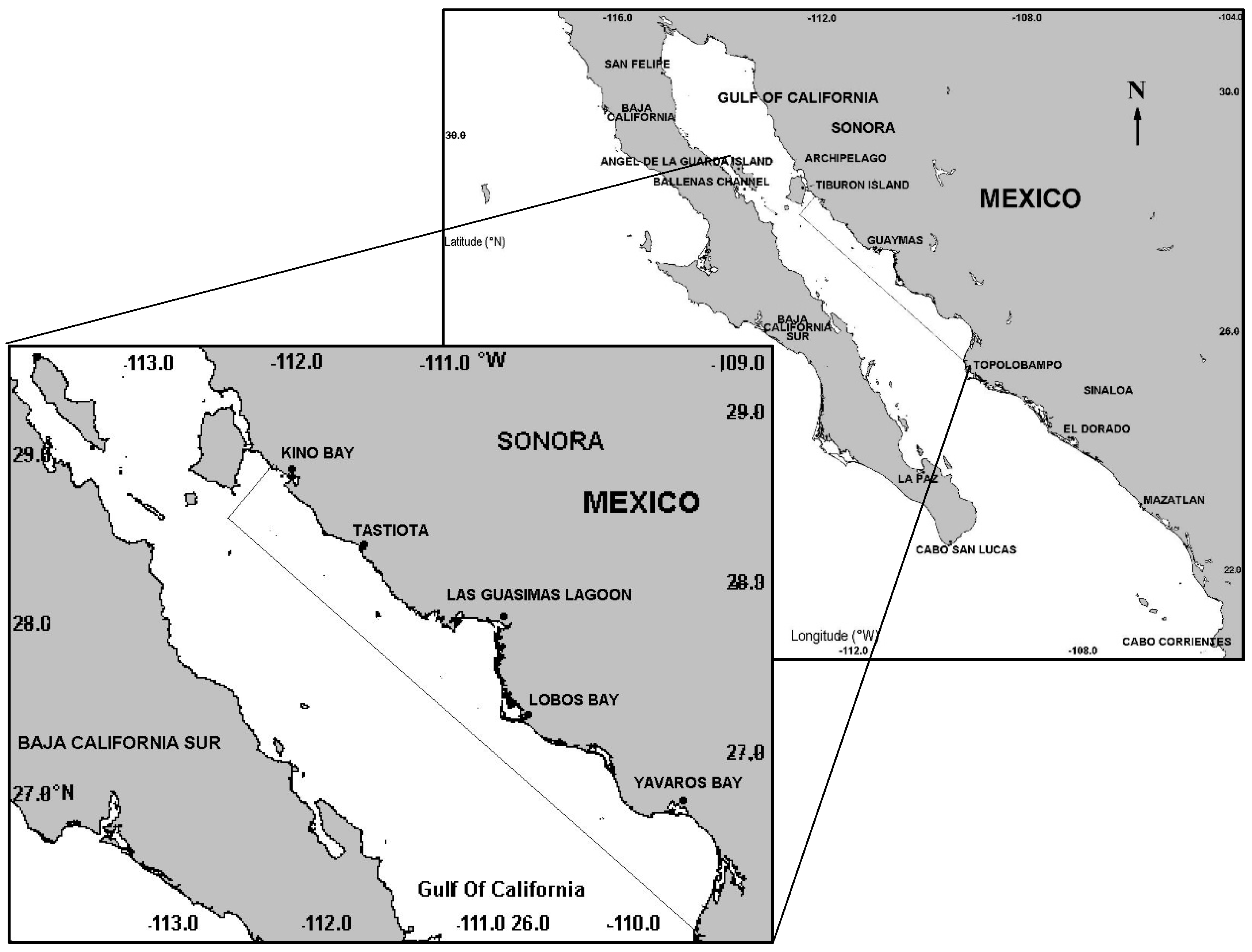
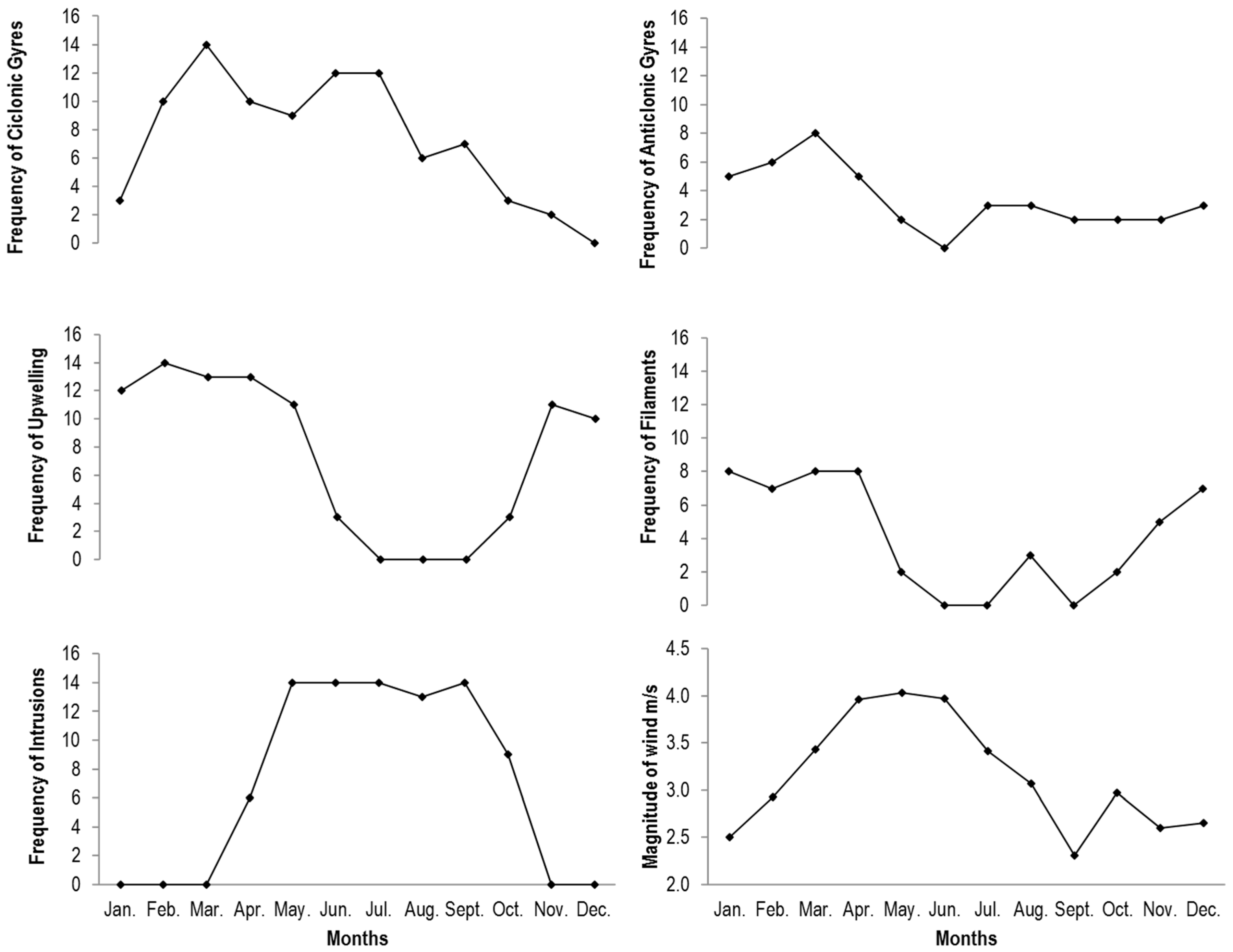
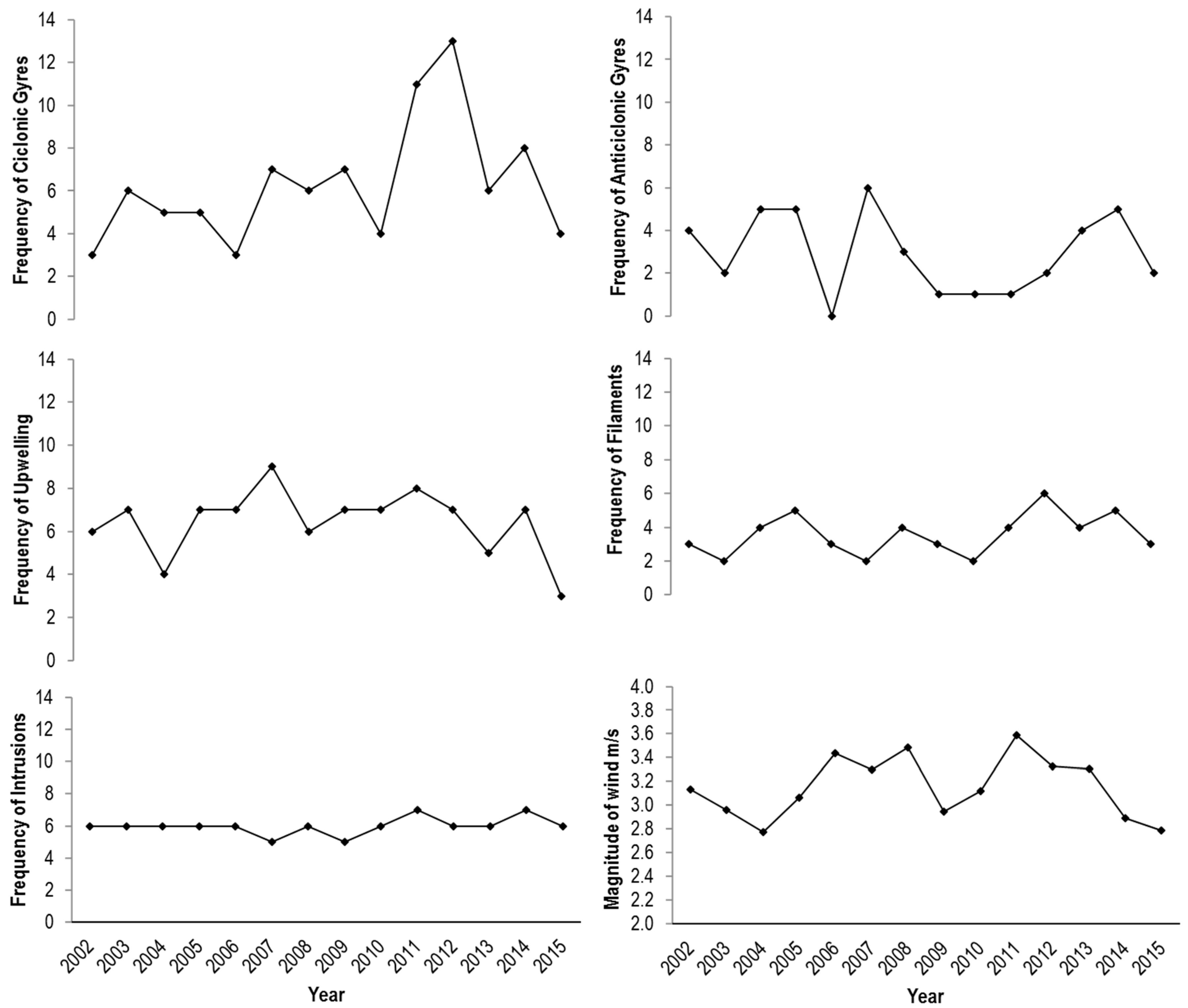
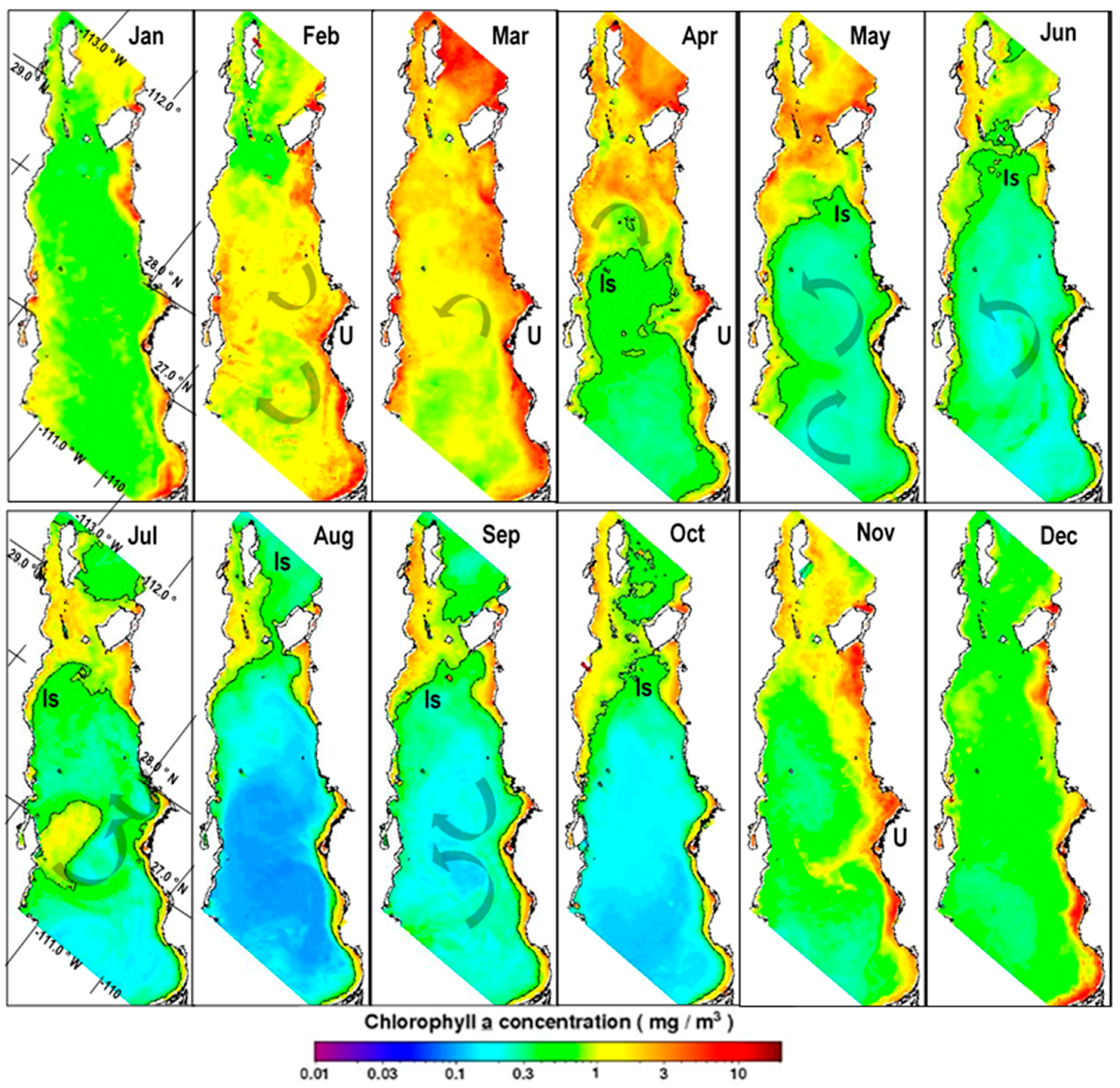
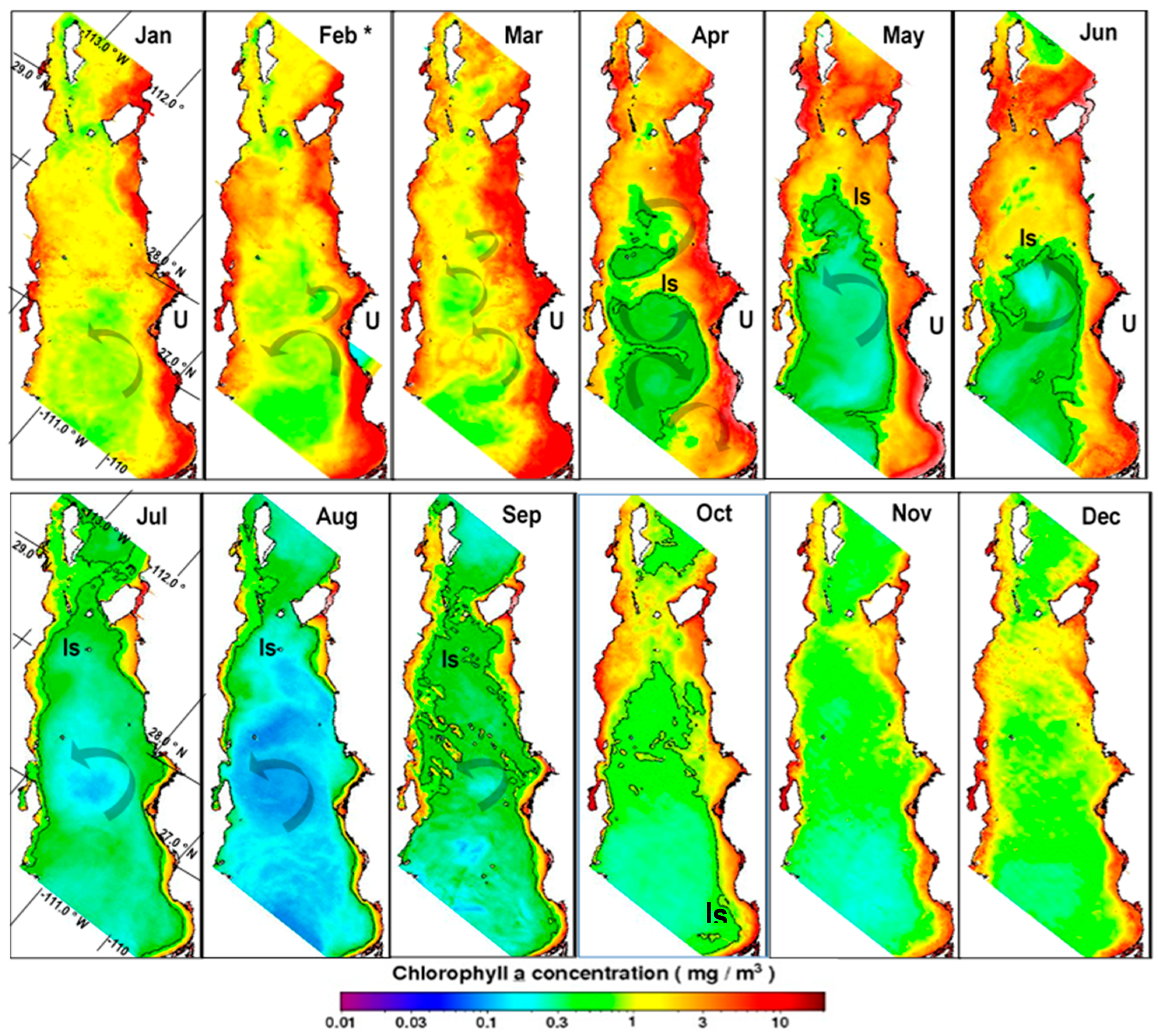
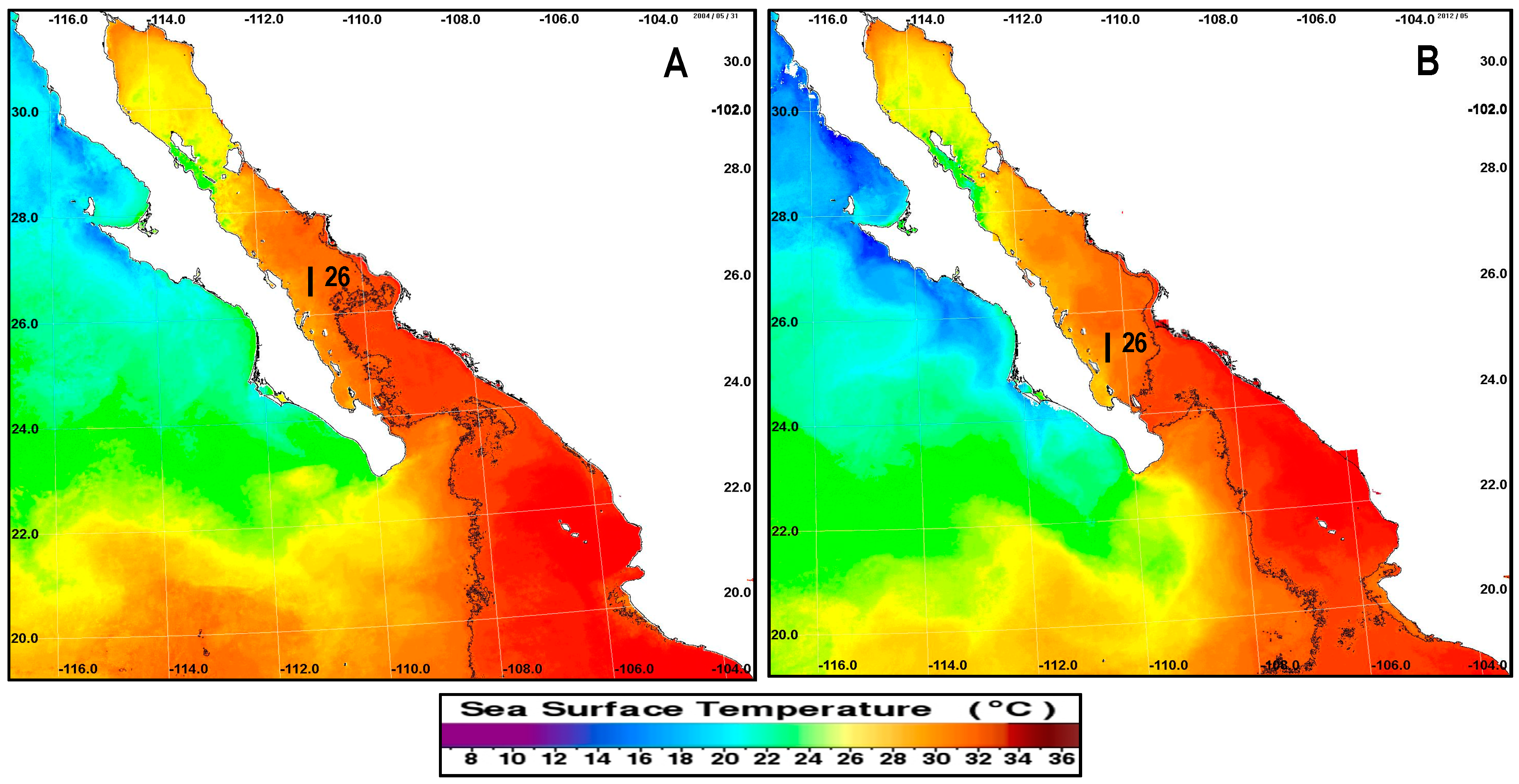
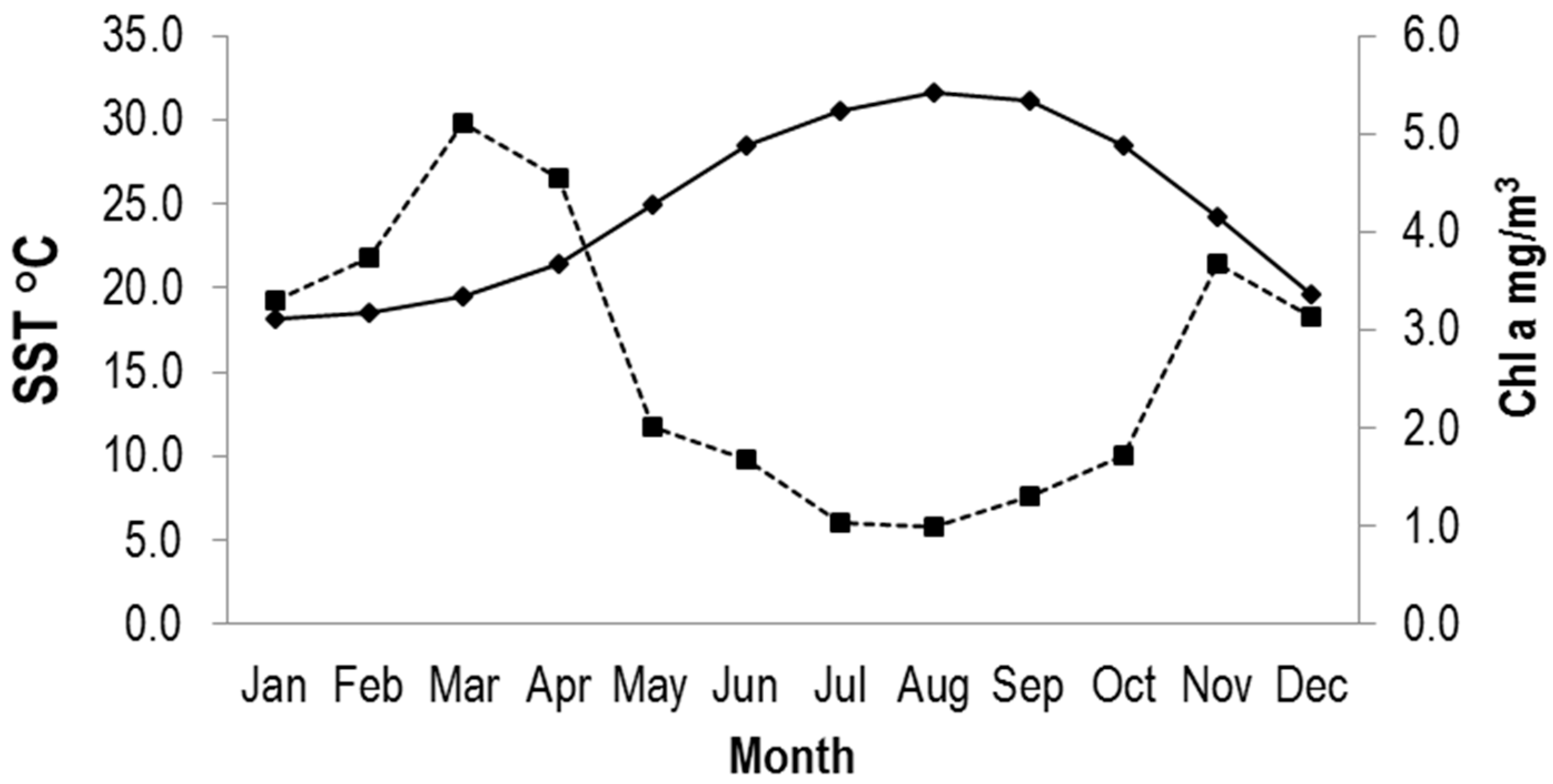
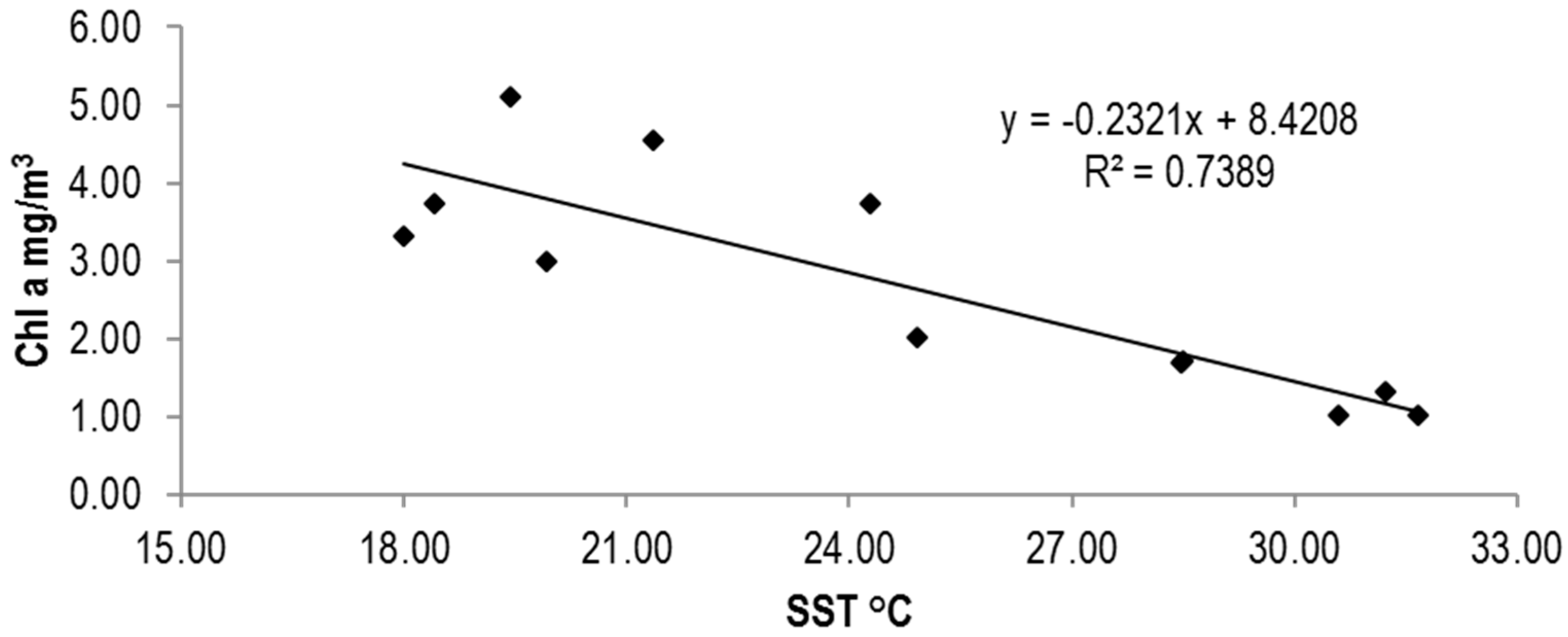
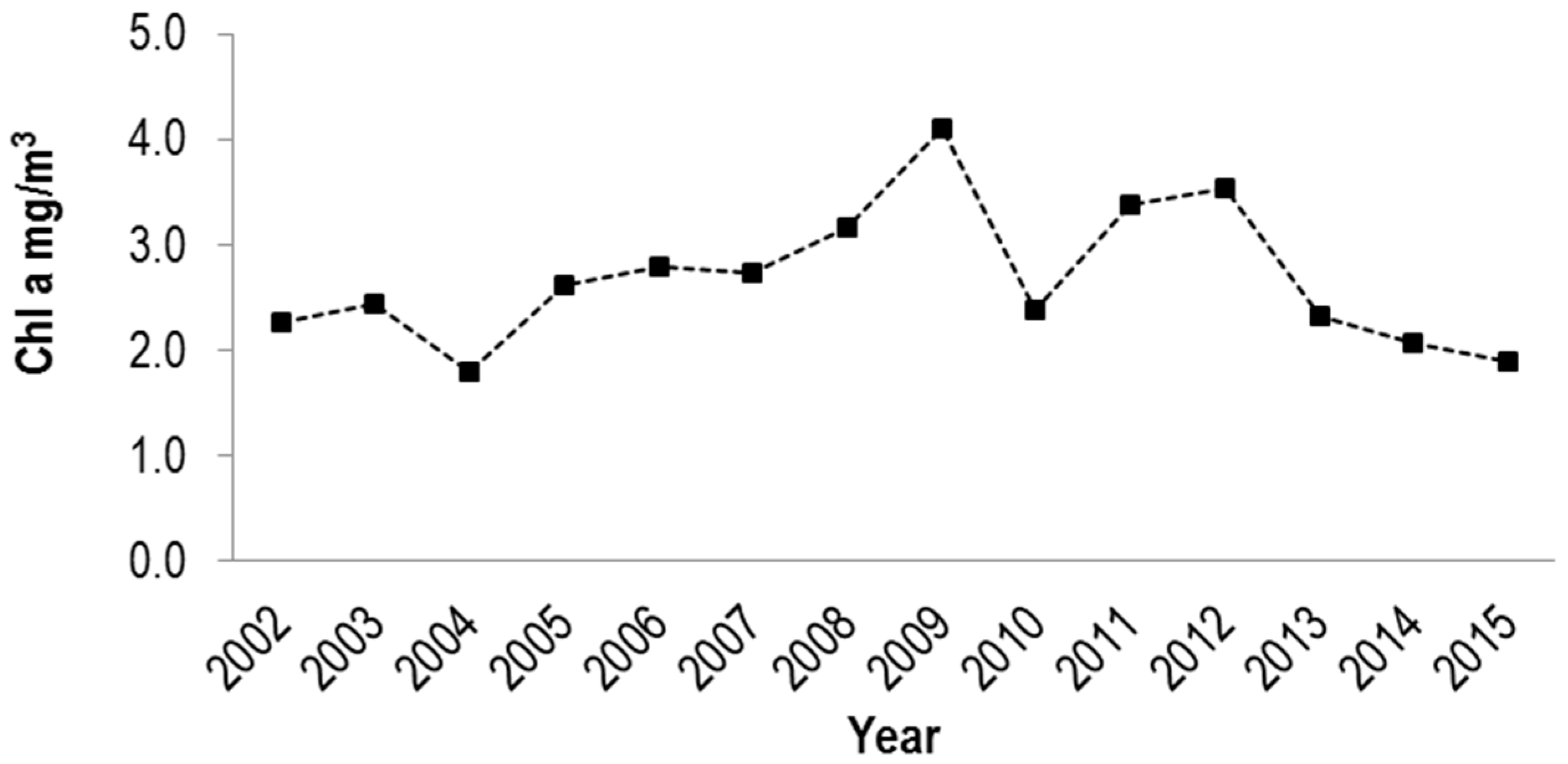
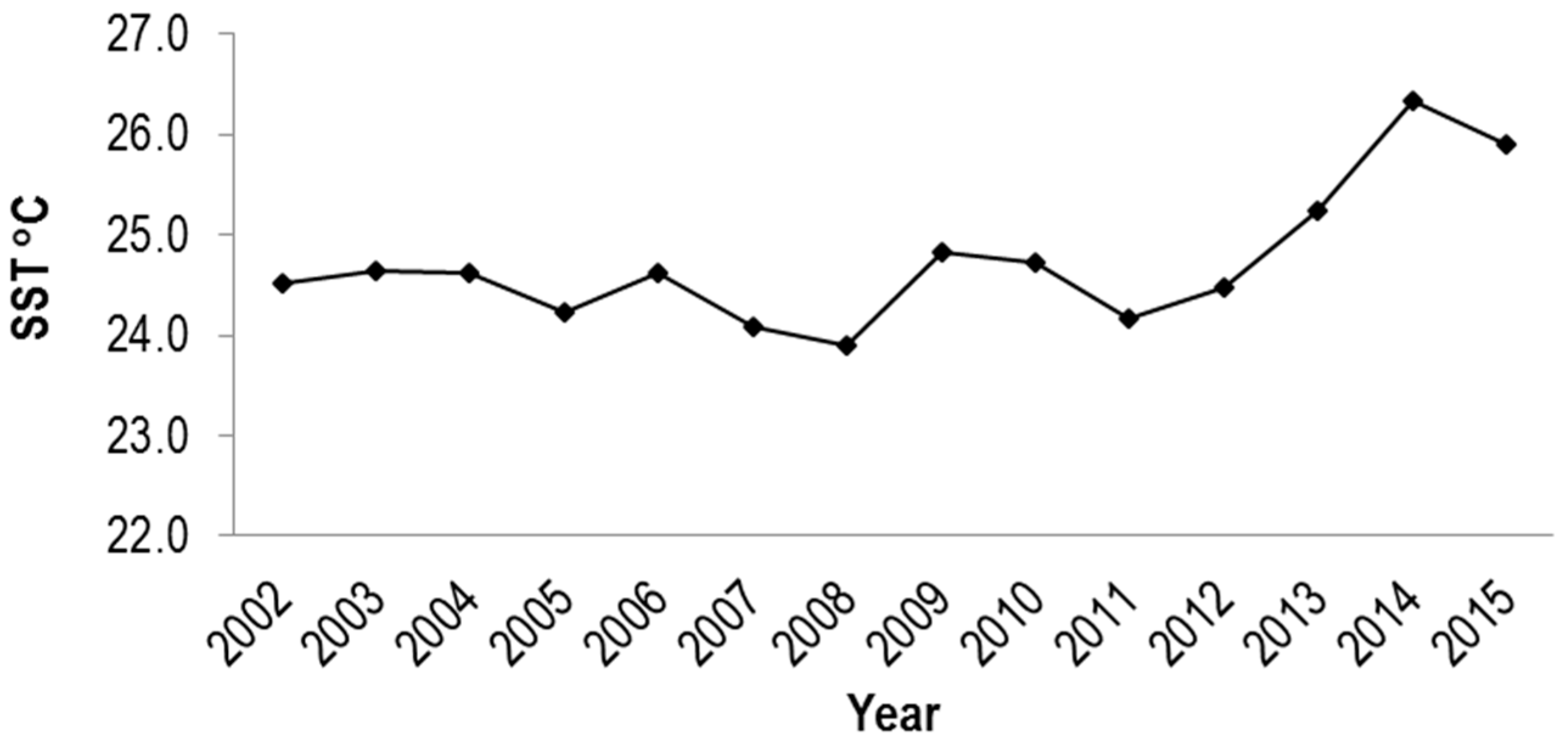
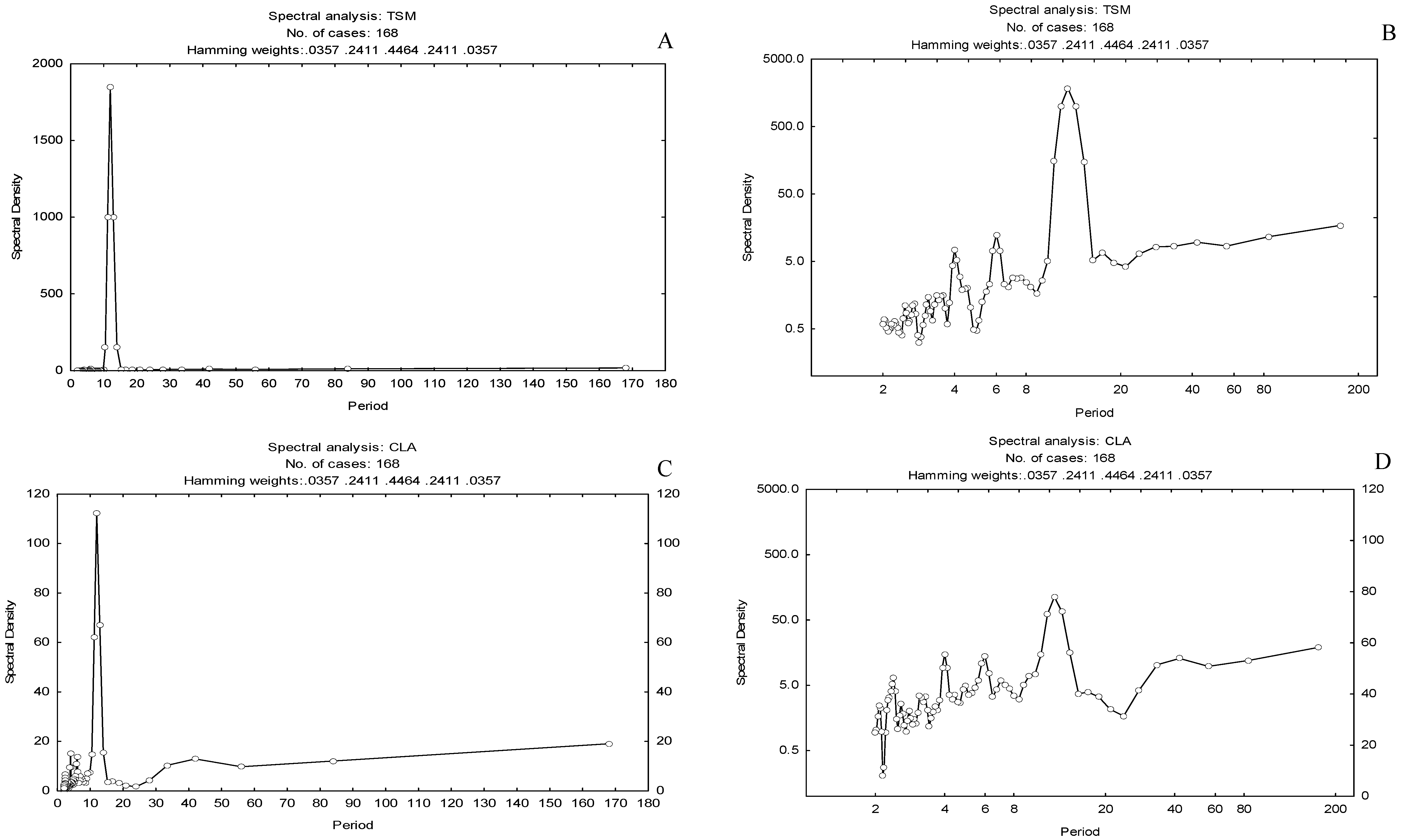
| Phenomena | Year | |||||||||||||||||||||||||||||||||||||||||
|---|---|---|---|---|---|---|---|---|---|---|---|---|---|---|---|---|---|---|---|---|---|---|---|---|---|---|---|---|---|---|---|---|---|---|---|---|---|---|---|---|---|---|
| Cyclonic Gyres | 2002 | 2003 | 2004 | 2005 | 2006 | 2007 | 2008 | 2009 | 2010 | 2011 | 2012 | 2013 | 2014 | 2015 | ||||||||||||||||||||||||||||
| No. of monthly observations of the phenomenon per year | 3 | 6 | 5 | 5 | 3 | 7 | 6 | 7 | 4 | 11 | 13 | 6 | 8 | 4 | ||||||||||||||||||||||||||||
| Length of the phenomenon in months per year | 1 | 1 | 1 | 5 | 1 | 3 | 1 | 2 | 1 | 1 | 1 | 1 | 2 | 2 | 3 | 2 | 1 | 2 | 7 | 1 | 3 | 6 | 3 | 1 | 9 | 2 | 2 | 2 | 2 | 2 | 4 | 4 | ||||||||||
| Mode of phenomena observations per month | 1 | 1 | 1 | 1 | 1 | 1 | 1 | 1 | 1 | 2 | 1 | 1 | 1 | 1 | ||||||||||||||||||||||||||||
| Maximum duration of the phenomenon in months | 1 | 5 | 3 | 2 | 1 | 3 | 2 | 7 | 3 | 5 | 9 | 2 | 4 | 4 | ||||||||||||||||||||||||||||
| Anticyclonic Gyres | ||||||||||||||||||||||||||||||||||||||||||
| No. of monthly observations of the phenomenon/year | 4 | 2 | 5 | 5 | 6 | 3 | 1 | 1 | 1 | 2 | 4 | 5 | 2 | |||||||||||||||||||||||||||||
| Length of the phenomenon in months per year | 3 | 1 | 1 | 1 | 2 | 1 | 1 | 1 | 1 | 1 | 3 | 1 | 1 | 1 | 1 | 1 | 1 | 1 | 1 | 1 | 1 | 2 | 3 | 2 | 1 | 1 | ||||||||||||||||
| Mode of phenomena observations per month | 1 | 1 | 1 | 1 | 1 | 1 | 1 | 1 | 1 | 1 | 1 | 1 | 1 | |||||||||||||||||||||||||||||
| Maximum duration of the phenomenon in months | 3 | 1 | 1 | 1 | 3 | 1 | 1 | 1 | 1 | 1 | 2 | 3 | 1 | |||||||||||||||||||||||||||||
| Upwelling | ||||||||||||||||||||||||||||||||||||||||||
| No. of monthly observations of the phenomenon/year | 6 | 7 | 4 | 7 | 7 | 9 | 6 | 7 | 7 | 8 | 7 | 5 | 7 | 3 | ||||||||||||||||||||||||||||
| Length of the phenomenon in months per year | 5 | 1 | 5 | 2 | 3 | 1 | 4 | 3 | 5 | 2 | 6 | 3 | 2 | 2 | 2 | 5 | 2 | 5 | 2 | 6 | 2 | 6 | 1 | 4 | 1 | 5 | 2 | 3 | ||||||||||||||
| Mode of phenomena observations per month | 1 | 1 | 1 | 1 | 1 | 1 | 1 | 1 | 1 | 1 | 1 | 1 | 1 | 1 | ||||||||||||||||||||||||||||
| Maximum duration of the phenomenon in months | 5 | 5 | 4 | 4 | 5 | 6 | 2 | 5 | 5 | 6 | 6 | 4 | 5 | 3 | ||||||||||||||||||||||||||||
| Filaments | ||||||||||||||||||||||||||||||||||||||||||
| No. of monthly observations of the phenomenon/year | 3 | 2 | 4 | 5 | 3 | 2 | 4 | 3 | 2 | 4 | 6 | 4 | 5 | 3 | ||||||||||||||||||||||||||||
| Length of the phenomenon in months per year | 1 | 1 | 1 | 2 | 1 | 1 | 2 | 2 | 1 | 3 | 1 | 1 | 1 | 1 | 2 | 1 | 2 | 3 | 1 | 4 | 1 | 1 | 2 | 2 | 1 | 3 | ||||||||||||||||
| Mode of phenomena observations per month | 1 | 1 | 1 | 2 | 1 | 1 | 1 | 1 | 1 | 1 | 1 | 1 | 1 | 1 | ||||||||||||||||||||||||||||
| Maximum duration of the phenomenon in months | 1 | 2 | 2 | 2 | 3 | 1 | 1 | 2 | 2 | 3 | 4 | 2 | 2 | 3 | ||||||||||||||||||||||||||||
| Intrusion | ||||||||||||||||||||||||||||||||||||||||||
| No. of monthly observations of the phenomenon/year | 6 | 6 | 6 | 6 | 6 | 5 | 6 | 5 | 6 | 7 | 6 | 6 | 7 | 6 | ||||||||||||||||||||||||||||
| Length of the phenomenon in months per year | 6 | 6 | 6 | 6 | 6 | 5 | 6 | 5 | 6 | 7 | 6 | 6 | 7 | 4 | 2 | |||||||||||||||||||||||||||
| Mode of phenomena observations per month | 1 | 1 | 1 | 1 | 1 | 1 | 1 | 1 | 1 | 1 | 1 | 1 | 1 | 1 | ||||||||||||||||||||||||||||
| Maximum duration of the phenomenon in months | 6 | 6 | 6 | 6 | 6 | 5 | 6 | 5 | 6 | 7 | 6 | 6 | 7 | 5 | ||||||||||||||||||||||||||||
| Environmental Variables | Percentage of Mesoscale Phenomena | ||||||
|---|---|---|---|---|---|---|---|
| SST °C | Chl-a mg/m3 | Cyclonic Gyres | Anti-Cyclonic Gyres | Upwelling | Filaments | Intrusions | |
| Month | |||||||
| January | 18.00 ± 1.29 bh | 3.31 ± 2.22 ab | 10.71 ± 16.17 ab | 17.86 ± 18.13 a | 42.86 ± 35.87 a | 28.57 ± 21.08 a | 0.00 ± 0.00 c |
| February | 18.41 ± 1.83 bgh | 3.74 ± 2.24 ab | 27.03 ± 21.46 ab | 16.22 ± 22.27 a | 37.84 ± 19.66 a | 18.92 ± 20.38 ab | 0.00 ± 0.00 c |
| March | 19.44 ± 1.46 bfgh | 5.11 ± 1.68 a | 32.56 ± 22.63 ab | 18.60 ± 21.56 a | 30.23 ± 28.18 ab | 18.60 ± 18.29 ab | 0.00 ± 0.00 c |
| April | 21.36 ± 1.28 bdefgh | 4.55 ± 1.53 a | 23.81 ± 22.89 ab | 11.90 ± 16.47 a | 30.95 ± 16.77 ab | 19.05 ± 23.18 ab | 14.29 ± 21.15 bc |
| May | 24.92 ± 0.84 bcdef | 2.01 ± 1.07 bcf | 23.68 ± 20.58 ab | 5.26 ± 10.03 a | 28.95 ± 20.26 ac | 5.26 ± 7.26 ab | 36.84 ± 20.08 ab |
| June | 28.47 ± 0.65 ae | 1.68 ± 1.68 cf | 41.38 ± 23.36 a | 0.00 ± 0.00 a | 10.34 ± 12.67 bc | 0.00 ± 0.00 b | 48.28 ± 27.90 ab |
| July | 30.61 ± 0.65 ac | 1.02 ± 0.25 f | 41.38 ± 23.99 a | 10.34 ± 13.15 a | 0.00 ± 0.00 c | 0.00 ± 0.00 b | 48.28 ± 28.21 ab |
| August | 31.67 ± 0.51 a | 1.02 ± 0.37 f | 24.00 ± 18.54 ab | 12.00 ± 0.00 a | 0.00 ± 18.62 c | 12.00 ± 31.09 ab | 52.00 ± 0.27 ab |
| September | 31.23 ± 0.39 a | 1.31 ± 0.39 cf | 30.43 ± 25.08 ab | 8.70 ± 15.48 a | 0.00 ± 0.00 c | 0.00 ± 0.00 b | 60.87 ± 27.09 a |
| October | 28.50 ± 0.76 ad | 1.70 ± 0.65 bcf | 15.70 ± 27.66 ab | 10.53 ± 10.72 a | 15.79 ± 18.62 bc | 10.53 ± 14.47 ab | 47.37 ± 47.86 ab |
| November | 24.27 ± 1.26 bcdefg | 3.73 ± 1.37 ab | 10.00 ± 14.01 ab | 10.00 ± 10.03 a | 55.00 ± 41.98 a | 25.00 ± 20.69 ab | 0.00 ± 0.00 c |
| December | 19.92 ± 1.97 bfgh | 3.00 ± 1.34 ac | 00.00 ± 0.00 b | 15.00 ± 16.98 a | 50.00 ± 36.75 ab | 35.00 ± 31.16 a | 0.00 ± 0.00 c |
| Year | |||||||
| 2002 | 24.52 ± 5.46 a | 2.27 ± 1.62 a | 13.64 ± 15.54 a | 18.18 ± 17.53 a | 27.27 ± 32.07 a | 13.64 ± 17.21 a | 27.27 ± 47.02 a |
| 2003 | 24.65 ± 5.04 a | 2.45 ± 1.90 a | 26.09 ± 23.67 a | 8.70 ± 10.76 a | 30.43 ± 45.59 a | 8.70 ± 15.05 a | 26.09 ± 32.11 a |
| 2004 | 24.61 ± 5.53 a | 1.79 ± 1.03 a | 20.83 ± 21.32 a | 20.83 ± 22.29 a | 16.67 ± 22.98 a | 16.67 ± 33.43 a | 25.00 ± 31.38 a |
| 2005 | 24.24 ± 5.19 a | 2.61 ± 2.02 a | 17.86 ± 22.34 a | 17.86 ± 22.95 a | 25.00 ± 22.91 a | 17.86 ± 24.31 a | 21.43 ± 43.25 a |
| 2006 | 24.62 ± 5.76 a | 2.80 ± 1.99 a | 15.79 ± 22.61 a | 0.00 ± 0.00 a | 36.84 ± 37.69a | 15.79 ± 22.61 a | 31.58 ± 43.30 a |
| 2007 | 24.09 ± 5.22 a | 2.75 ± 1.80 a | 24.14 ± 21.65 a | 20.69 ± 23.69 a | 31.03 ± 28.45 a | 6.90 ± 15.54 a | 17.24 ± 22.98 a |
| 2008 | 23.89 ± 5.83 a | 3.17 ± 1.99 a | 24.00 ± 23.81a | 12.00 ± 16.57 a | 24.00 ± 32.82 a | 16.00 ± 14.97 a | 24.00 ± 38.92 a |
| 2009 | 24.83 ± 5.44 a | 4.11 ± 3.58 a | 30.43 ± 23.96 a | 4.35 ± 7.22 a | 30.43 ± 31.67 a | 13.04 ± 19.82 a | 21.74 ± 32.92 a |
| 2010 | 24.71 ± 4.90 a | 2.39 ± 1.34 a | 20.00 ± 33.43 a | 5.00 ± 9.62 a | 35.00 ± 41.72 a | 10.00 ± 16.60 a | 30.00 ± 33.43 a |
| 2011 | 24.16 ± 6.18 a | 3.39 ± 1.78 a | 35.48 ± 26.42 a | 3.23 ± 4.81 a | 25.81 ± 36.32 a | 12.90 ± 16.76 a | 22.58 ± 42.12 a |
| 2012 | 24.48 ± 5.70 a | 3.53 ± 1.94 a | 38.24 ± 21.12 a | 5.88 ± 8.25 a | 20.59 ± 17.48 a | 17.65 ± 18.45 a | 17.65 ± 22.32 a |
| 2013 | 25.23 ± 4.81 a | 2.32 ± 1.71 a | 24.00 ± 22.60 a | 16.00 ± 18.28 a | 20.00 ± 30.64 a | 16.00 ± 17.53 a | 24.00 ± 38.57 a |
| 2014 | 26.34 ± 4.39 a | 2.07 ± 1.05 a | 25.00 ± 22.71 a | 15.63 ± 18.23 a | 21.88 ± 17.81 a | 15.63 ± 18.23 a | 21.88 ± 31.67 a |
| 2015 | 25.90 ± 4.73 a | 1.89 ± 1.08 a | 22.22 ± 20.55 a | 11.11 ± 11.49 a | 16.67 ± 13.97 a | 16.67 ± 13.97 a | 33.33 ± 46.87 a |
| Correlation Per Month between Mesoscale Phenomena and Environmental Variables | ||||||||
|---|---|---|---|---|---|---|---|---|
| Environmental Variables | Mesoscale Phenomena | Effect | ||||||
| January | SST | Chl-a | Cyclonic Gyres | Anti-Cyclonic Gyres | Upwelling | Filaments | Intrusions | Upwelling ↑-Cyclonic and Anticyclonic Gyres ↓ |
| Cyclonic Gyres | −0.56 | |||||||
| Anti-cyclonic Gyres | −0.62 | |||||||
| February | SST ↓-Chl-a ↑ | |||||||
| SST | −0.78 | |||||||
| March | SST ↓-Chl-a ↑ | |||||||
| SST | −0.63 | |||||||
| April | SST ↓-Chl-a ↑, Filaments ↑-Intrusions ↓ | |||||||
| SST | −0.74 | |||||||
| Filaments | −0.53 | |||||||
| May | Cyclonic Gyres ↑-Upwelling ↓, Intrusion ↑-Filaments and Cyclonic Gyres ↓ | |||||||
| Cyclonic Gyres | −0.67 | −0.69 | ||||||
| Filaments | −0.65 | |||||||
| June | Intrusions ↑-Cyclonic Gyres and Upwelling ↓ | |||||||
| Cyclonic Gyres | −0.67 | |||||||
| Upwelling | −0.75 | |||||||
| July | Cyclonic Gyres ↑-Chl-a ↑, Intrusions ↑-Cyclonic and Anticyclonic Gyres ↓ | |||||||
| Chl-a | 0.59 | |||||||
| Cyclonic Gyres | −0.64 | |||||||
| Anti-cyclonic Gyres | −0.69 | |||||||
| August | Anticyclonic Gyres and Filaments ↑-Chl-a ↓, Intrusions ↑-Anticyclonic Gyres ↓ | |||||||
| Chl-a | −0.60 | −0.51 | ||||||
| Anti-cyclonic Gyres | −0.54 | |||||||
| September | Intrusions ↑-SST ↑, Intrusions ↑-Cyclonic Gyres ↓ | |||||||
| SST | 0.54 | |||||||
| Cyclonic Gyres | −0.76 | |||||||
| October | Intrusions ↑-SST ↑, Cyclonic and Anticyclonic Gyres ↑-SST ↓, Upwelling and filaments ↑-Chl-a ↑, Intrusions ↑-Chl-a ↓, Upwelling ↑-Filaments ↑ | |||||||
| SST | −0.55 | −0.54 | 0.54 | |||||
| Chl-a | 0.69 | 0.60 | −0.56 | |||||
| Upwelling | 0.74 | |||||||
| December | Upwelling ↑-Chl-a ↑, SST ↑-Upwelling ↓ | |||||||
| SST | −0.58 | |||||||
| Chl-a | 0.65 | |||||||
| Environmental Variables | Climate Index | ||||
|---|---|---|---|---|---|
| Month | |||||
| TSM °C | Chl-a mg/m3 | Winds m/s | ENSO | PDO | |
| January | 18.00 ± 1.29 bh | 3.31 ± 2.22 ab | 2.40 ± 0.57 b | −0.12 ± 0.84 a | 0.22 ± 1.17 a |
| February | 18.41 ± 1.83 bgh | 3.74 ± 2.24 ab | 2.90 ± 0.79 bd | −0.16 ± 0.71 a | 0.16 ± 1.08 a |
| March | 19.44 ± 1.46 bfgh | 5.11 ± 1.68 a | 3.48 ± 0.59 ad | −0.11 ± 0.54 a | 0.11 ± 1.07 a |
| April | 21.36 ± 1.28 bdefgh | 4.55 ± 1.53 a | 4.00 ± 0.49 ac | −0.05 ± 0.44 a | 0.17 ± 0.96 a |
| May | 24.92 ± 0.84 bcdef | 2.01 ± 1.07 bcf | 4.04 ± 0.42 a | 0.01 ± 0.39 a | 0.23 ± 1.05 a |
| June | 28.47 ± 0.65 ae | 1.68 ± 1.68 cf | 4.05 ± 0.44 a | 0.07 ± 0.42 a | 0.06 ± 0.87 a |
| July | 30.61 ± 0.65 ac | 1.02 ± 0.25 f | 3.38 ± 0.40 ad | 0.11 ± 0.51 a | −0.18 ± 1.15 a |
| August | 31.67 ± 0.51 a | 1.02 ± 0.37 f | 0.65 ± 0.48 bcd | −0.21 ± 1.15 a | −0.14 ± 1.42 a |
| September | 31.23 ± 0.39 a | 1.31 ± 0.39 cf | 2.34 ± 0.72 b | 0.17 ± 0.80 a | −0.33 ± 1.21 a |
| October | 28.50 ± 0.76 ad | 1.70 ± 0.65 bcf | 2.96 ± 0.51 bd | 0.21 ± 0.96 a | −0.31 ± 1.08 a |
| November | 24.27 ± 1.26 bcdefg | 3.73 ± 1.37 ab | 2.58 ± 0.59 bd | 0.21 ± 1.02 a | −0.31 ± 1.14 a |
| December | 19.92 ± 1.97 bfgh | 3.00 ± 1.34 ac | 2.60 ± 0.52 bd | 0.14 ± 1.09 a | 0.06 ± 1.18 a |
| Year | |||||
| 2002 | 24.52 ± 5.46 a | 2.27 ± 1.62 a | 3.13 ± 0.79 a | 0.62 ± 0.52 ac | 0.22 ± 0.86 ae |
| 2003 | 24.65 ± 5.04 a | 2.45 ± 1.90 a | 2.96 ± 0.94 a | 0.28 ± 0.31 acd | 0.97 ± 0.59 a |
| 2004 | 24.61 ± 5.53 a | 1.79 ± 1.03 a | 2.77 ± 0.67 a | 0.43 ± 0.26 acd | 0.35 ± 0.46 ad |
| 2005 | 24.24 ± 5.19 a | 2.61 ± 2.02 a | 3.06 ± 0.86 a | 0.14 ± 0.41 ae | 0.38 ± 1.03 ad |
| 2006 | 24.62 ± 5.76 a | 2.80 ± 1.99 a | 3.44 ± 0.59 a | 0.16 ± 0.57 ae | 0.19 ± 0.61 ae |
| 2007 | 24.09 ± 5.22 a | 2.75 ± 1.80 a | 3.30 ± 0.62 a | −0.40 ± 0.62 bde | −0.20 ± 0.63 bcde |
| 2008 | 23.89 ± 5.83 a | 3.17 ± 1.99 a | 3.49 ± 0.91 a | −0.68 ± 0.42 be | −1.29 ± 0.37 b |
| 2009 | 24.83 ± 5.44 a | 4.11 ± 3.58 a | 2.95 ± 0.67 a | 0.33 ± 0.70 ac | −0.61 ± 0.79 bde |
| 2010 | 24.71 ± 4.90 a | 2.39 ± 1.34 a | 3.12 ± 0.77 a | −0.33 ± 1.03 bce | −0.31 ± 0.95 bcde |
| 2011 | 24.16 ± 6.18 a | 3.39 ± 1.78 a | 3.59 ± 0.94 a | −0.70 ± 0.34 be | −1.23 ± 0.66 be |
| 2012 | 24.48 ± 5.70 a | 3.53 ± 1.94 a | 3.33 ± 0.96 a | −0.12 ± 0.39 bce | −1.10 ± 0.58 be |
| 2013 | 25.23 ± 4.81 a | 2.32 ± 1.71 a | 3.30 ± 0.76 a | −0.26 ± 0.10 bde | −0.52 ± 0.41bde |
| 2014 | 26.34 ± 4.39 a | 2.07 ± 1.05 a | 2.89 ± 0.84 a | 0.01 ± 0.40 bce | 1.13 ± 0.65 ac |
| 2015 | 25.90 ± 4.73 a | 1.89 ± 1.08 a | 2.79 ± 0.77 a | 1.26 ± 0.70 a | 1.63 ± 0.49 a |
| Environmental Variables | Climate Index | Effect | ||||
|---|---|---|---|---|---|---|
| January | SST | Chl-a | Winds | ENSO | PDO | |
| SST | 0.63 | 0.54 | PDO and ENSO ↑-SST ↑-Chl-a ↓, ENSO ↓-Winds ↑, PDO ↑-ENSO ↑ | |||
| Chl-a | −0.63 | −0.70 | ||||
| ENSO | −0.65 | 0.68 | ||||
| February | SST | Chl-a | Winds | ENSO | PDO | |
| SST | 0.62 | 0.62 | PDO and ENSO ↑-SST ↑-Chl-a ↓, PDO ↓-Winds ↑ PDO ↑-ENSO ↑ | |||
| Chl-a | −0.68 | −0.67 | ||||
| ENSO | 0.79 | |||||
| PDO | −0.53 | |||||
| March | SST | Chl-a | Winds | ENSO | PDO | |
| SST | 0.61 | 0.74 | PDO and ENSO ↑-SST ↑, PDO ↓-Chl-a and Cyclonic Gyres ↑, ENSO ↓-Filaments ↑ | |||
| Chl-a | −0.67 | |||||
| Cyclonic Gyres | −0.67 | |||||
| Filaments | −0.55 | |||||
| April | SST | Chl-a | Winds | ENSO | PDO | |
| SST | −0.59 | PDO and ENSO ↓-Winds ↑, SST ↑-Winds ↓, PDO ↑-ENSO ↑ | ||||
| ENSO | −0.63 | 0.597 | ||||
| PDO | −0.53 | |||||
| May | SST | Chl-a | Winds | ENSO | PDO | |
| SST | −0.63 | SST ↑-Winds ↓, ENSO ↓-Winds ↑, ENSO ↑-Chl-a ↓ PDO ↑-ENSO ↑ | ||||
| Chl-a | −0.71 | |||||
| ENSO | −0.57 | 0.53 | ||||
| Jun | SST | Chl-a | Winds | ENSO | PDO | |
| Chl-a | −0.59 | −0.64 | PDO and ENSO ↑-Chl-a ↓, PDO ↓-Winds ↑ | |||
| PDO | −0.56 | |||||
| July | SST | Chl-a | Winds | ENSO | PDO | |
| Chl-a | −0.71 | PDO ↑-Chl-a ↓ | ||||
| August | SST | Chl-a | Winds | ENSO | PDO | |
| Chl-a | −0.62 | ENSO ↑-Chl-a ↓, ENSO ↓-Anti-cyclonic Gyres ↑, ENSO ↓-Intrusions ↓ | ||||
| Anti-cyclonic Gyres | 0.65 | |||||
| Intrusions | −0.53 | |||||
| September | SST | Chl-a | Winds | ENSO | PDO | |
| ENSO | −0.55 | 0.60 | PDO and ENSO ↑-Winds ↓, PDO ↑-ENSO ↑ | |||
| PDO | −0.55 | |||||
| October | SST | Chl-a | Winds | ENSO | PDO | |
| Chl-a | −0.66 | PDO ↑-Chl-a ↓, ENSO ↑-Winds and Cyclonic Gyres ↓, PDO ↑-Intrusions ↑ | ||||
| Cyclonic Gyres | −0.63 | |||||
| Intrusions | 0.58 | |||||
| ENSO | −0.53 | 0.77 | ||||
| November | SST | Chl-a | Winds | ENSO | PDO | |
| ENSO | 0.72 | PDO ↓-ENSO ↑ | ||||
| December | SST | Chl-a | Winds | ENSO | PDO | |
| SST | 0.72 | 0.55 | PDO ↑- ENSO ↓-SST ↓, PDO ↑-ENSO ↑ | |||
| ENSO | 0.73 | |||||
© 2017 by the authors. Licensee MDPI, Basel, Switzerland. This article is an open access article distributed under the terms and conditions of the Creative Commons Attribution (CC BY) license (http://creativecommons.org/licenses/by/4.0/).
Share and Cite
García-Morales, R.; López-Martínez, J.; Valdez-Holguin, J.E.; Herrera-Cervantes, H.; Espinosa-Chaurand, L.D. Environmental Variability and Oceanographic Dynamics of the Central and Southern Coastal Zone of Sonora in the Gulf of California. Remote Sens. 2017, 9, 925. https://doi.org/10.3390/rs9090925
García-Morales R, López-Martínez J, Valdez-Holguin JE, Herrera-Cervantes H, Espinosa-Chaurand LD. Environmental Variability and Oceanographic Dynamics of the Central and Southern Coastal Zone of Sonora in the Gulf of California. Remote Sensing. 2017; 9(9):925. https://doi.org/10.3390/rs9090925
Chicago/Turabian StyleGarcía-Morales, Ricardo, Juana López-Martínez, Jose Eduardo Valdez-Holguin, Hugo Herrera-Cervantes, and Luis Daniel Espinosa-Chaurand. 2017. "Environmental Variability and Oceanographic Dynamics of the Central and Southern Coastal Zone of Sonora in the Gulf of California" Remote Sensing 9, no. 9: 925. https://doi.org/10.3390/rs9090925




